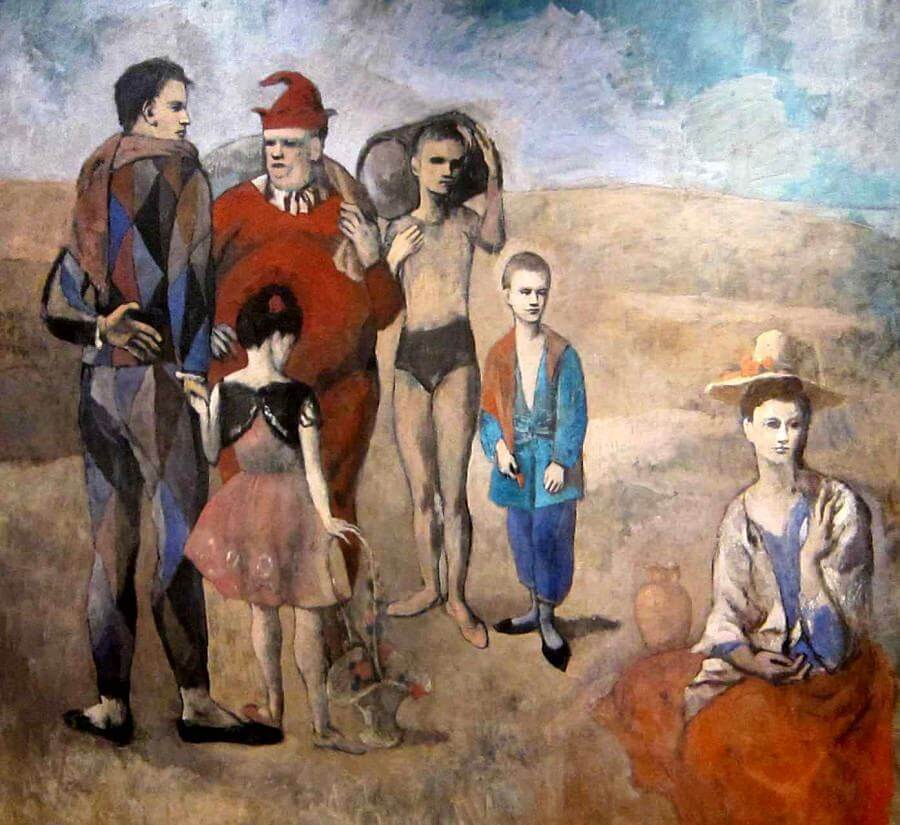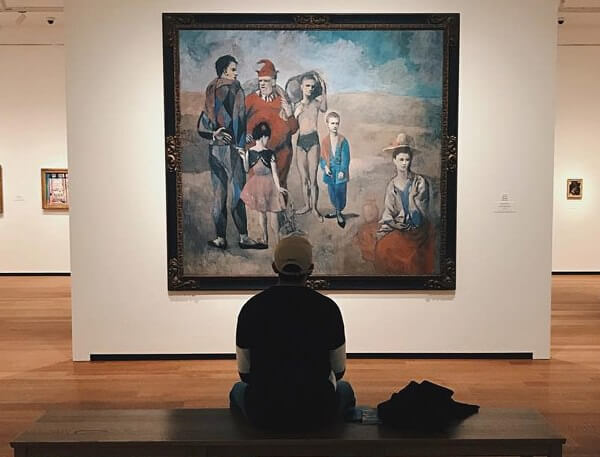Saltimbanques (The Family of Saltimbanques), 1905

This picture is usually seen as the dominant composition of Picasso's Rose Period - the conclusion of developing style, colouring and themes to date. A massive canvas, in fact, the largest that Picasso ever worked on at 212.8x229.6cm, (7x8 ft), was the outcome of several preliminary studies, including elements taken from Young Acrobat on a Ball (1905). The background was originally a racecourse until Picasso created this barren landscape, which is reminiscent of his birthplace in Andalucia, southern Spain.
The circus troupe is assembled as if departing, both literally and metaphorically, in terms of Picasso's development. Picasso is again Harlequin, holding the little girl, possibly his beloved younger sister, Conchita, whose tragic death from diphtheria at the age of seven affected Picasso deeply. He bargained that he would never paint again if she survived, so her death created his first obsessive, recurrent connection between art, life and death in his work. The paunchy jester is the Symbolist Apollinaire, and the older boy-acrobat is either the poet Max Jacob or the poet Andre Salmon. Picasso's lover of the time, Fernande, is probably the woman strangely separated from the group

The fresco-like colours create the haunting mood of this deserted landscape, a dislocated pastoral scene emptied of life except for the figures, and also oddly separated from the traditional 'big-top' setting. As several critics have remarked, it has instead much in common with Manet's monumental, frieze-like composition of 1862, The Old Musician. This was included in the Manet retrospective held in the Salon d'Automne in 1900, and the fortuitous similarity in subject matter would surely have attracted Picasso's attention, prompting perhaps his final concerted effort to simplify and abstract his composition. Manet had often been accused by Salon critics of painting 'incomprehensible' pictures since no one was able to identify a coherent or consequential narrative within them. Some critics complained: 'There is much that is arbitrary in his compositions', and other contemporaries dismissed The Luncheon on the Grass as 'an uncouth riddle'. The Old Musician is one of Manet's least conventional compositions and the interpretation of its imagery continues to exercise and divide scholars. Inconsequentiality or 'arbitrariness' is the hallmark of Family of Saltimbanques, and it may have been Edouard Manet who gave Picasso the courage to compose as casually on so imposing a scale.
Circus scene has been a popular subject matter for many avant-garde artists in the early 20th century. Among those artists, Georges Seurat painted The Circus, Edgar Degas created Miss La La at the Cirque Fernando and Pierre-Auguste Renoir delineated Acrobats at the Cirque Fernando. One of the benefits of such a busy scene is that there are so many subtleties to be discovered. The bright colors allow this painting to be used as a focal point in almost any room, and the little nuances will pull viewers closer time and time again. The unique style of Picasso paintings has never been more evident than in the The Family of Saltimbanques.
















